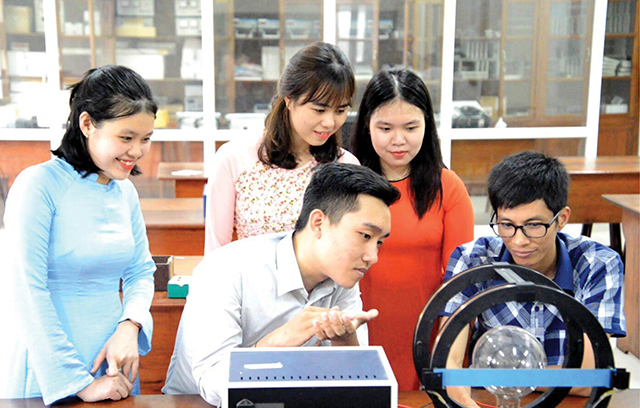
Assoc. Prof. Bui Dinh Hoi (on the right) in the laboratory
Passionate, busy and successful
Without explanation, I would have thought that Bui Dinh Hoi (working at the University of Education, Hue University) has a “weird” interest. There are children toys, lipsticks and a couple of scratchy handwriting on the wall. He reassured me with a brief explanation: “I take my children to the lab with me as there’s no nursery on Sunday.”
Being busy has become part of his life since he was at school. He was considered by friends as a bookworm for his passion in doing research. As soon as he graduated from the University of Education (Hue University) in 2005, he started his postgraduate studies and engaged in research in low dimensional semiconductor materials.
After he became a young lecturer at the National University of Civil Engineering, Hanoi, in 2008, he applied to further study for better specialization in teaching and research.
For almost 6 years of doing his doctoral studies (since 2009), Bui Dinh Hoi successfully defended his doctoral thesis at all levels (i.e., the faculty, the institution and the national university) and worked at the University of Education, Hue University, afterwards. He said that he was one of the special cases for being granted the associate professorship thanks to his research. To become an associate professor, one must have at least three years after earning the doctorate degree, apart from the required core criteria.
Hoi said, “it was a good chance when I met an experienced professor who revealed that a special consideration is applicable for those researchers whose number of research works is twice as many as is required, no matter how long. I found that until the time I logged my application for the title, I had 36 journal articles, 21 of which are ISI-indexed. This accounted for three times of the required points. For this, I was entitled Associate Professor in 2017, at the age of 34.”
In his current academic treasure, young Associate Professor Bui Dinh Hoi has a huge number of works, including 60 international ISI-indexed journal articles (not to mention the publications at the national level). Especially in 2018, Bui Dinh Hoi impressively published 19 articles in ISI-indexed journals. He has also been the chief investigator of a NAFOSTED project and the participant in other three ones.
Speaking of his achievements, he modestly admitted that he had great passion rather than talent. He said, “Fortunately, I had the chance to work with well-experienced supervisors as well as national and international talented colleagues. I myself only have passion. I got married and had our first child in 2010 during my doctoral studies. I was busy with the baby during the day, so I had to stay up late to complete the work. It was the passion and aspiration that help me see the research through.”
Assoc. Prof., Dr Nguyen Dinh Luyen, Vice-rector of the University of Education, Hue University, commended, “young as Hoi is, he proves to be a talent, which is evident in his international publications. He has taken advantage of his specialization in Theoretical Physics to do research anywhere anytime.”
Desire for health and time
When I asked “aren’t you tired?” Bui Dinh Hoi honestly said, “I really am, but when I think about the incomplete work, the passion and motivation are recovered and then I go on with it.”
The young Associate Professor explains that, unlike the applied research that usually yields particular products, his research direction in Theoretical Physics is to further explore the materials and their new effects. The values of his works will support empirical and experimental research, contribute to explaining, orienting and predicting future research.
Since he started higher education, Bui Dinh Hoi has been consistent with his research direction in the physics of solidified substances and he always strives to explore something new. He said, “To keep doing without knowing whether it is successful is the nature of doing research. If one is hesitant to try, there’s nothing to contribute to science.” This way of thinking leads Bui Dinh Hoi to research in single-atomic-layer materials after he succeeded with traditional low-dimensional semiconductor materials.
Doing research and sitting for a long time in the lab causes some health problems. According to his wife, Dr. Le Thi Thu Phuong, the fifty-kilo man goes to hospital at least once a year. He is sometimes seen lying on the patient bed typing the research report.
Assoc. Prof. Bui Dinh Hoi explained, “my work can be done via a laptop. I sometimes wish to have better health and more time for teaching and doing research.”
The only thing Bui Dinh Hoi feels guilty is he spends little time with his child. He honestly revealed, “I and my wife are both lecturers and researchers. We usually let our child play with a smartphone to have time for work although we understand the adverse effects of technology on young children.”
The 36-year-old associate professor said that this concern would be balanced because he managed to find ways for more appropriate working schedule. Fortunately, he and his wife have reunited in Hue and worked for the same university. This is a good chance for him to spend more time with his child and achieve more ambitious goals, that is, the research of high quality and values.
Story and photo: Huu Phuc